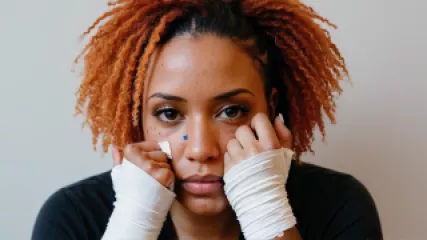Overcoming Self-Harm: An Interview with a Survivor
Overcoming Self-Harm: An Interview with a Survivor
An Interview with Amanda Neal: A Journey of Hope and Healing
Self-harm is a deeply personal and complex issue that affects millions of individuals worldwide. It is a coping mechanism that can take various forms, from cutting and burning to hair-pulling and self-hitting. For many, the road to recovery can be long and arduous, marked by setbacks and challenges. However, there are those who have found the strength to overcome this struggle and reclaim their lives.
In this candid interview, we sit down with Amanda Neal, a survivor who has courageously shared her journey of self-harm and her path to healing. Amanda's story is one of resilience, hope, and the power of community support. Her willingness to open up and share her experiences is a testament to the importance of breaking the silence surrounding this issue and offering a guiding light to those who are currently navigating their own battles.
The Onset of Self-Harm
Amanda's journey with self-harm began at a young age, as she grappled with the aftermath of a traumatic event. "I was around 12 years old when I first started self-harming," she recalls, her voice steady yet tinged with the weight of those memories. "It started with small cuts on my arms, and it quickly spiraled into a coping mechanism that I relied on to manage the overwhelming emotions I was experiencing."
For Amanda, the act of self-harm provided a temporary sense of relief, a way to physically manifest the inner turmoil she was battling. "It was as if the physical pain could somehow numb the emotional pain. I felt a sense of control and release when I would hurt myself, even though I knew deep down that it was only a temporary fix."
As the years passed, Amanda's self-harm escalated, leading to more severe injuries and a growing sense of isolation. "I became very skilled at hiding my scars and the physical evidence of what I was doing. I would wear long sleeves, even in the summer, and make excuses to avoid situations where my arms might be exposed."
The Turning Point
Amanda's turning point came when she found herself in a crisis situation, facing the very real possibility of losing her life. "I had reached a breaking point where the self-harm had become completely unmanageable. I was in a dark place, and I knew that I needed help if I was going to survive."
It was at this moment that Amanda made the courageous decision to reach out for support. "I finally opened up to a trusted therapist about what I was going through. It was one of the most difficult conversations I've ever had, but it was also the beginning of my journey towards healing."
With the guidance of her therapist and the support of her loved ones, Amanda began to explore the root causes of her self-harm and develop healthier coping mechanisms. "It wasn't an easy process, and there were many setbacks along the way. But I was determined to break the cycle and reclaim my life."
The Road to Recovery
Amanda's road to recovery was paved with a combination of therapy, self-reflection, and the development of new coping skills. "One of the biggest breakthroughs for me was learning to identify and address the underlying issues that were driving my self-harm. It wasn't just about the physical act of hurting myself; it was about finding healthier ways to manage my emotions and trauma."
Through her therapy sessions, Amanda delved into the complex emotions and experiences that had led her to self-harm. "I had to confront a lot of painful memories and beliefs about myself. It was hard, but it was also necessary for my healing."
Alongside her therapeutic work, Amanda also discovered the power of alternative coping mechanisms. "I started exploring things like mindfulness, art therapy, and exercise as ways to manage my emotions in a healthy way. It was amazing to see how these activities could provide a sense of release and calm without the need for self-harm."
Throughout her recovery journey, Amanda also found strength in the support of her loved ones. "Having a strong support system was crucial for me. My family and friends were there to listen, to validate my feelings, and to encourage me every step of the way. They helped me to believe that I was worth fighting for."
The Importance of Community Support
As Amanda's recovery progressed, she realized the profound impact that community support can have on individuals struggling with self-harm. "When I was in the depths of my self-harm, I felt so alone and ashamed. I thought that I was the only one going through this, and that no one could possibly understand."
However, Amanda's perspective shifted when she discovered online support groups and resources for individuals affected by self-harm. "Connecting with others who had been through similar experiences was life-changing. I realized that I wasn't alone, and that there were people out there who could truly empathize with what I was going through."
Through these online communities, Amanda found a safe space to share her story, seek advice, and draw inspiration from others who were also on the path to recovery. "The sense of community and belonging was so powerful. It reminded me that I was worthy of support and that there were people who truly cared about my well-being."
Advice for Those Struggling with Self-Harm
As someone who has walked the difficult road of self-harm and emerged with newfound strength, Amanda has a powerful message to share with those who are currently battling this challenge.
"The most important thing is to know that you are not alone, and that there is hope. Self-harm may feel like the only way to cope, but I can assure you that there are healthier and more fulfilling paths forward."
Amanda emphasizes the importance of reaching out for support, whether it's to a trusted loved one, a therapist, or an online community. "Opening up about your struggles can be terrifying, but it's also the first step towards healing. Don't be afraid to be vulnerable and ask for help."
She also encourages individuals to explore alternative coping mechanisms that align with their personal interests and needs. "Find activities that bring you joy, calm, or a sense of control. Whether it's art, exercise, or mindfulness, discover what works best for you and make it a part of your self-care routine."
Most importantly, Amanda wants those struggling with self-harm to know that they are worthy of love, support, and a fulfilling life. "You are so much more than your struggles. Believe in your own resilience and know that you have the power to overcome this. Your story is not over yet."
A Message of Hope
As Amanda's journey has shown, the path to recovery from self-harm is not an easy one, but it is a journey that is possible. Through her willingness to share her story, Amanda hopes to inspire others who are walking a similar path and to provide a glimmer of hope in the midst of darkness.
"My message to anyone struggling with self-harm is this: you are not alone, and you are stronger than you know. Keep fighting, keep reaching out, and know that there are people and resources available to support you every step of the way. Your life is precious, and you deserve to live it to the fullest."
Amanda's story is a testament to the power of resilience, community support, and the unwavering belief in one's own worth. By sharing her journey, she hopes to contribute to the ongoing effort to destigmatize mental health and empower those who are facing their own battles with self-harm.
Resources for Those Affected by Self-Harm
If you or someone you know is struggling with self-harm, there are resources and support available:
- National Suicide Prevention Lifeline: 1-800-273-8255 (available 24 hours every day)
- Crisis Text Line: Text HOME to 741741 to connect with a crisis counselor
- Self-Harm Hotline: 1-800-366-8288
- Online Support Communities:
Remember, you are not alone, and there is help available. Reach out and take that first step towards healing and recovery.
If you or someone you know is in immediate danger, please call the National Suicide Prevention Lifeline at 1-800-273-8255 or go to the nearest emergency room.






